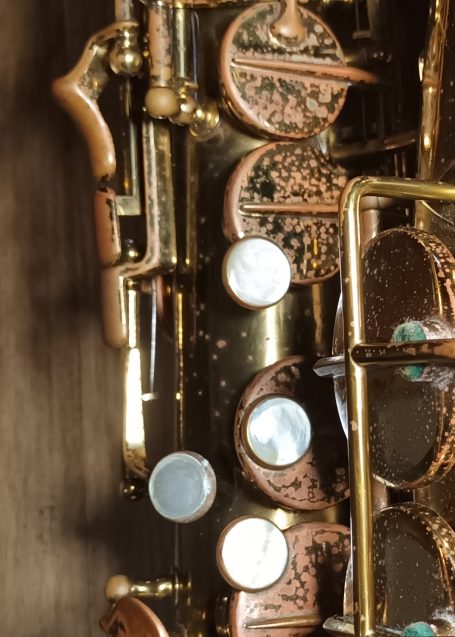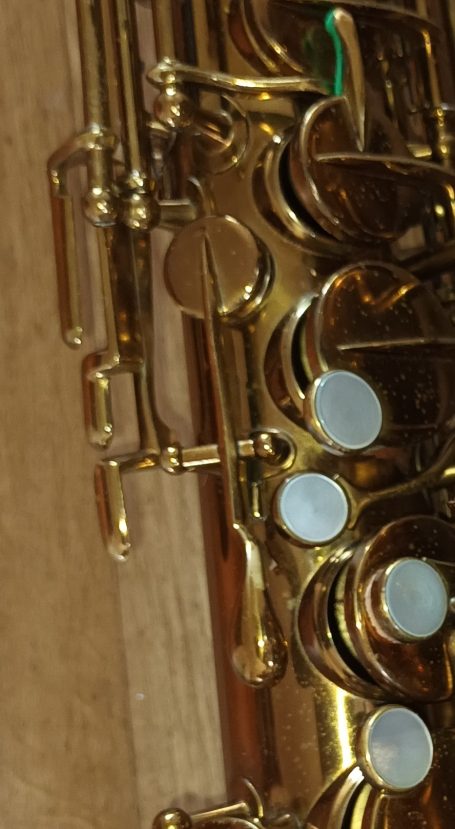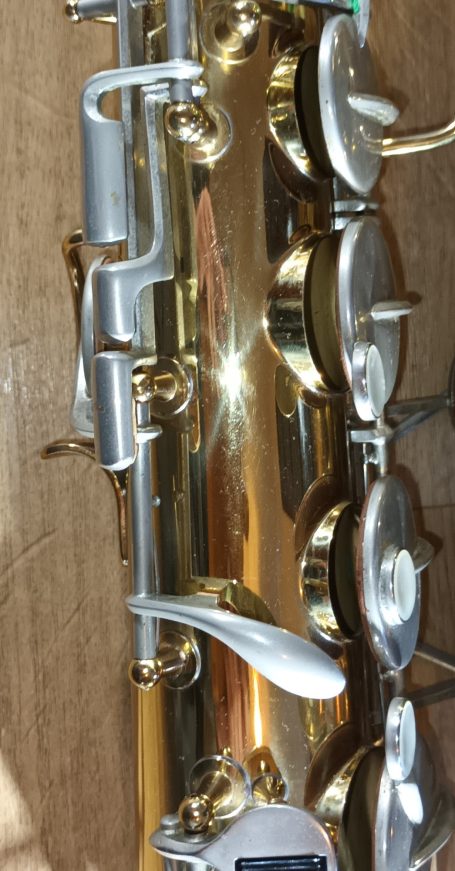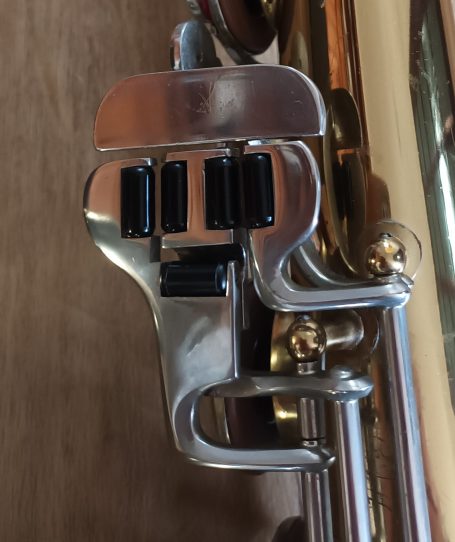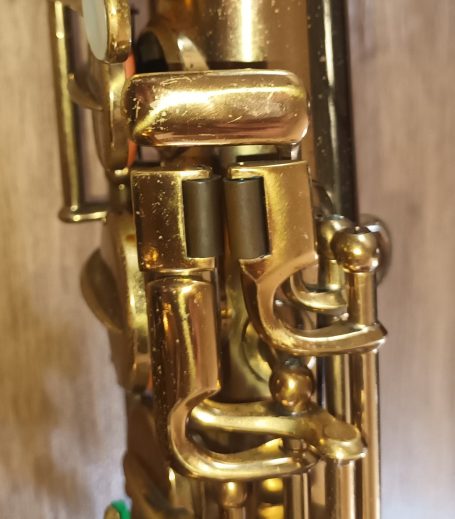Vintage And Antique Saxophone Guide
How old is too old for a saxophone you want use? This guide lists the main features you need to be aware of so your vintage saxophone is playable in many situations.
If you enjoy collecting instruments then nothing will be too old. Some will be simply be less useful for playing some styles of music.
If you are thinking about buying a saxophone as an investment – Stop! There are only a few brands and models which hold their value. None really appreciate in value after you include price inflation. If you look online, you will see hundreds of Selmer Mark VI in shops gathering dust at high prices for example.
There is nothing wrong with vintage saxes in the context of playing music of the past such as swing or big band. It gives more authenticity to the music. Some people consider vintage instruments to be more difficult to play but, if you listen to recordings of Benny Carter, Charlie Parker, Don Byas or Coleman Hawkins you will notice they do not seem to be having any problems playing at considerable speed on their vintage saxes.
Summary
- A Low Pitch instrument will be more useful than a High Pitch one.
- If intonation is especially important, instruments made in the mid 1990’s onwards are much better and more consistent than any produced earlier. When you play-test the instrument, use a tuner to see if the tuning tendencies are going to work for you.
- The left-hand pinkie key table may take a while to get used to.
- The key positions may be less comfortable (but they could be better depending on how large your hands are).
- The instrument must have a front F key and a side F# (high F# is optional).
- Avoid non-standard pad fitment (clip-in or screw-in) unless you have the tools and equipment to adjust pads when needed.
- Vintage tenor saxes are often lighter and easier to handle despite having ergonomic differences.
Modern altos and sopranos made from mid-1990’s onwards with post construction are excellent at all price points when in good playing order. Tenor saxophones based on designs from the 1940’s and 50’s are good for jazz and big band. Baritone players should look for the low A key and make sure the instrument has a foot or enough space to attach one.
You will not lose much money on a vintage sax if you do not get used to it after a few months. Tenor players may feel a real improvement in timbre and blowing resistance with an older model. A stencil instrument (store or export only brand) will be more affordable and are usually functionally identical to the premium brand.
For beginners, a good quality used instrument from the 1990’s onwards would be an affordable starting point. If the student decides it is not for them, the financial losses will be minimal.
When purchasing a used instrument of any age, make sure it has been serviced and is in good playing order. This will maximise your enjoyment and prevent unexpected repair bills.
Duncan Saunders 4-Apr-2025
Condition
The condition of a saxophone can be assessed in two areas; cosmetic and functional.
Cosmetic qualities such as lacquer or lack of and previous repairs are a matter of personal taste. Some people may find a gnarly and crusty looking instrument to be fantastic while others may be concerned about if it would play. The reality is that lacquer simply protects the instrument from surface tarnish. Many instruments can be kept looking good simply by removing dust with a soft brush and rubbing any unprotected brass with hands to bring back its lustre.
Functionality is much more important when buying an instrument of any age. Check for play in the keys both side to side and if any key bounces on its hinge rod. If there is any play in rods it can be removed easily but make sure this work is done before parting with any money.
Also check the pads. If they are very dry they will need replacing. A full repad can be very expensive.
Missing cork bumpers can cause tuning and playability issues but is relatively inexpensive to have corrected.
Areas of severe wear are usually the neck tenon and strap ring. A loose tenon will leak making the instrument unplayable. If your repairer has the correct tools, this is an easy fix. A worn strap ring is a sign the instrument has been used a lot. I consider this a good thing, if an instrument has been used a lot it is certain to be good. Replacing a strap ring is not expensive and prevents the instrument falling to the floor causing damage.
Minor dents and bruises do not affect the tuning but check carefully if there is a dent near a tone hole. The tone hole may not be level causing leaks. Generally, dents happen on the bow when the instrument falls. The D palm key is usually bent out of line too. Intonation can be affected if there are severe dents in the main body tube above the G key towards the tenon and anywhere on the neck. I class a dent as being severe if it can be easily seen from 2 meters away or has deformed the tube so it is out of round or is pushing more than a sixth of diameter into the body. Most vintage saxes have small dents all over and these will not cause any problems.
A recently repadded and serviced used saxophone should play as good as new, the only real difference should be cosmetic patina from time and use.
Feature List
Extra Keys
American Saxophones in the 1930’s and 40’s had active research and development which added features which do not appear on later instruments.
The main ones being the G# trill key and Eb trill key (also called Forked E).
The G# trill key is on the lower stack between the F (4) and E (5) keys. When G# is played a lever rises and the player can trill G# more easily than using the usual key.
The Eb trill or forked E key is where the D key (6) has a rod which holds down E when pressed. The E button can rise independently which opens another tone hole to produce the note Eb. This feature adds complexity to these keys and the extra pad and timing considerations can easily create leaks.
Since additional keys do not appear on modern saxophones, you can easily live without them. It should be noted that more affordable stencil and student models produced in the same era do not have the extra keys.
Removable Bell
Almost all saxes made after the mid 1990’s and those made by Selmer Paris from the late 1950’s have a removable bell. The bell is glued to the body and clamped in place. It is removable for ‘cleaning purposes’. Similar to rib construction ‘adding tone’ this is sales nonsense. A removable bell makes manufacturing a lot easier since the body tube and all the keys can be assembled in one location. The bell can be attached in another factory ‘making’ the saxophone. This is a great way to work around trade tariffs as the body tube and bell are just components of little value until they are assembled.
The removable bell also allows key posts and screws to be in awkward positions meaning that the bell has to be removed for routine jobs and adjustments. It adds time and costs to repairs. This is an area where the vintage sax wins – they are easily and quickly repairable and adjustable.
Clip-In and Screwed-In Pads
Buescher had a clip-in pad system on almost all their saxes. Buffet and Crampon had a screwed in pad (like a flute) on their Super Dynamic Action saxes.
The concept is fine; a saxophone is a marching band instrument so it is likely to be played outside in all weathers and the pads will get damaged easily by water and damp. Making pad changes easy and fast sounds like a good idea. But it is not because the keys will need to be removed to get to the key cup and this will be beyond most people. Also, the clips and screws could easily fall out which will cause problems mid-performance.
From my own experience with a Buescher, I found the pads would move around a lot with temperature changes especially through autumn into winter. Giving up time to check and adjust the pads weekly during these seasons was inconvenient. Good quality glued-in standard pads which have been fitted well should last a long time if well looked after.
Ribs or Post Construction
Selmer Mark VI and almost all saxes made from the mid 1990’s onwards with the exception of Jupiter, Yamaha and very few others use rib construction. This is a long plate with the posts for the key rods attached. All it does is help is improve manufacturing efficiency because the posts can be added to the rib away from the instrument. The rib can then be soldered onto the instrument more quickly and accurately. More skill and tooling is required to accurately place and solder each post individually to the body.
Ribs add considerable weight and reduce skill and time to manufacture. They do not affect the tone that much regardless of what the sales brochure may say.
The same applies to double key arms – it just adds weight.
Tone Holes On The Bell
Older saxophones may have the bell tone holes on the left or both sides. For alto, you may not notice the difference.
Tenor and Baritone players may find that bell keys on the left side will always be clanking on the chair when they play sat down.
Tone Holes
Many vintage Conn, some Keilworth and Kohlert saxophones have rolled tone holes.
This type of tone hole features a lip on the top of the tone hole which helps the pad seat more easily than a straight cut hole. It also adds strength without adding weight.
Very few modern saxes have rolled tone holes, Keilworth, P. Mauriat & System 54 being the only ones I have seen.
Saxophones made by Martin and a few others have soldered on tone holes. These take the form of a thick metal ring with a bevelled top. Over time, without careful drying of the instrument, the solder can corrode causing leaks from the base of the tone hole. These leaks can be very difficult to diagnose which means they could be expensive to fix. However, I have worked on several of these instruments and they have not had problems despite being over 90 years old. However, Flutes with soldered tone holes have given me trouble and been very difficult to work on. Saxophones with soldered tone holes should be reliable provided there is evidence they have been looked after reasonably well.
I would avoid sopranos with soldered tone holes. Since the size is similar to a flute, any problems with the solder will be difficult to correct.
For alto and larger sizes, these are a positive addition to the instrument. Pads will last longer (Martin guaranteed the pads on their saxes for 20 years!). I would have a preference to rolled tone holes if I had to choose between several instruments.
Many older instruments designed before the 1950’s have all their main tone holes in one line. This puts the main body keys in a different place for the lower (4, 5, 6) keys. Some people may find the position change less comfortable especially when playing sat down. Instruments based on Selmer Paris Super Balanced Action tend to have the lower key stack offset.
Older tenor saxophones tend to have the G key (key 3) in-between keys so it does not press Bb. This is the same as modern Yamaha tenors and gives more room in the upper key stack. You will have some additional options for altissimo notes but may find the additional space uncomfortable.
Lower key stack button positions vary a lot more than modern instruments. Some layouts are more comfortable than others.
General Ergonomics
Additional Octave Keys
Some antique saxophones do not have a linkage which changes the octave vent automatically to the neck. There will be two separate keys for each vent. Do not confuse these for low A keys. The sax will be very hard to play in the upper register.
Palm Keys
Some early sopranos do not have all the palm keys. You will need the notes these keys produce at some point, even if it is just for trills.
Low A on Baritone Saxophone
This is optional for swing and jazz band unless you are planning on playing modern arrangements when it should be considered essential.
Side F#
Usually a long flat T shaped key above the side F# key. High F# is useful for modern music and playing altissimo. There are suitable fingerings to work around it being not being there if the instrument does not have this key. It adds weight and is an additional pad to leak.
Almost all players can live without this additional key. It started appearing as standard from the mid 1970’s onwards.
High F#
There can be confusion with the side F# and with the high F# key. They are next to each other on the sax near the lower stack. While high F# is optional, side F# is not as it is useful for trills and quick passages.
Side F# often appears as a round or oval button, sometimes as a spatula or a small spoon key.
If the Side F# is missing, the instrument will not be useful.
Front F
If there is no front F above the B button it will certainly be an antique instrument and not particularly useful. It could be retrofitted by a technician but with there being so many vintage saxes for sale it may not be cost effective.
Front F can take the form of a button or spatula key. Some require a stretch to operate which may be uncomfortable.
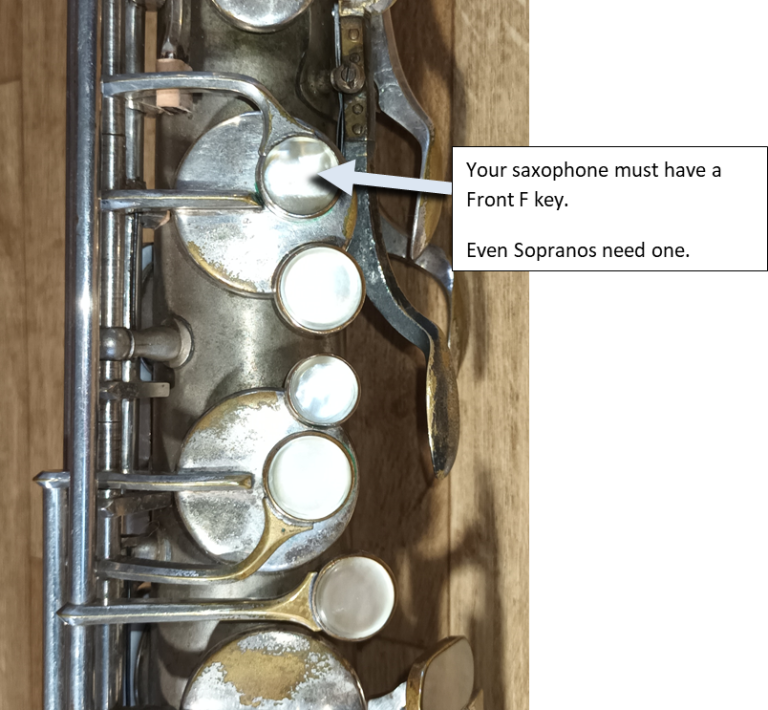
If the key table does not have four buttons, the sax will have fewer lower notes and be less useful.
Left-Hand Pinkie Keys
There is considerable variation in this area on vintage saxophones. This is the area which is the most different on an older saxophone and will take time to get used to.
You should note that on many 1930’s and earlier saxophones, pressing any low C#, B or Bb will not raise G#. While this helps prevent leaks, if you rely on this feature, you will need to adjust your technique to adapt.
C# usually requires more effort to press and you will need to build strength in your pinkie finger.
There are 3 broad types of key table:
High Pitch and Low Pitch
Before 1939, there was no internationally agreed tuning pitch. Americans used A4 = 440Hz (Low Pitch) and Europeans used A4 = 442Hz (High Pitch).
Even after 1939 when it was internationally agreed that the note A4 should be 440Hz many European manufacturers continued to produce instruments at high pitch until they stopped making those models.
All American made – including instruments imported to the USA will be Low Pitch. It is safe to assume that all European instruments made until the 1960s’ will be High Pitch unless noted otherwise.
You may find a tell-tale on the instrument to determine if it is low pitch. Buffet and Crampon instruments have a letter A in the serial number for example.
All instruments made during and after the 1960’s will be low pitch.
Does the two Hertz difference cause a problem?
The table below shows the difference between the tuning systems over several octaves.

For musical purposes we use the cents value in considering the difference between pitches. 1 cent is 100th of a semitone, so there are always 1200 cents per octave even though an octave is double the starting frequency.
As the pitch gets higher, the difference between pitches becomes wider. This will cause intonation issues when playing with others.
However, there are some notes on the saxophone which do not play in tune at the best of times and the player has to make their own physical adjustments to bring the note into tune. You will need to experiment with mouthpieces to make the tuning tendencies easier to adjust to.
For the sake of predictable tuning, a Low Pitch instrument will be more useful.
If very precise intonation is especially important to you, instruments made from the mid 1990’s onwards have much better tuning and are more consistent than any produced earlier.
We need your consent to load the translations
We use a third-party service to translate the website content that may collect data about your activity. Please review the details in the privacy policy and accept the service to view the translations.

